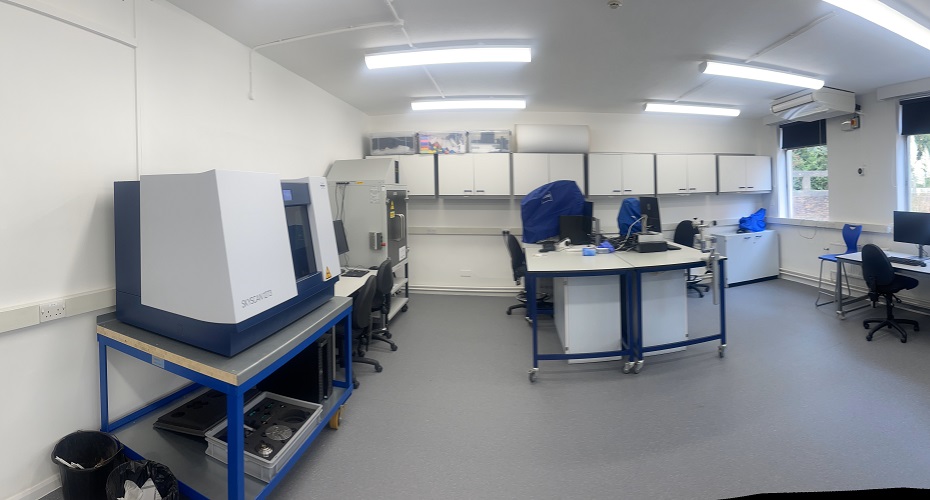Facilities
We have outstanding facilities that include: experimental archaeology laboratories; clean lab with fume cupboards for chemical work; a landscape archaeology project office, complete with giant scanner for maps and plans; microscope room equipped with highspec microscopes and image processing facilities; a kiln room for ceramics and other experimental purposes; wet labs for artefact and environmental sample processing; sets of high- and low-power teaching microscopes and state-of-the-art surveying equipment (including resistivity equipment, magnetometer, differential and hand-held GPS and total station theodolite). We also have extensive reference collections of artefacts, animal bones and plant remains.
Teaching
The University provides an excellent range of diverse learning spaces. We teach our larger classes in well-equipped lecture theatres around campus, but we also teach smaller seminar and practical classes within our own teaching rooms and laboratories. The larger of Archaeology and History's own teaching rooms is used for both practical and thematic modules; it is equipped with a full Audio-Visual system and electronic projector. There is a smaller teaching room often used for hands-on practical modules, such as zooarchaeology. It is also used for many MA modules and is equipped with the same AV system for use in lectures. These rooms can also be used for project work.
Bioarchaeology
We have a new bioarchaeology lab dedicated to the study of anatomical variation, palaeopathological conditions, and the funerary context of human and animal remains. The laboratory, accompanied by a designated store for our collection of human remains, provides facilities for use by researchers and students for examining skeletal remains recovered from archaeological sites. Equipment includes anatomical casts and demographic reference standards used to determine the sex, age-at-death, stature and body proportions from human remains.
Wet Lab
Archaeology has two interconnected wet laboratories. These are intended for the processing of dirty or messy objects and are commonly used for cleaning finds from excavations and initial processing of soil samples. They are also available for environmental sample processing activities and are often used by students who need somewhere to analyse artefacts. Both laboratories have a large number of work surfaces, two sinks and drying racks. These labs can also be used for storing finds and samples.
Clean Lab
The clean laboratory is used for chemical processes and circumstances where contamination is a concern and is often used for environmental sample processing, such as the preparation of phytolith and starch samples. It is equipped with two large fume cabinets for the use of toxic chemicals.
SHArD Lab

The Science Heritage and Archaeology Digital (SHArD) 3D Lab is equipped with state-of-the-art equipment to cover a wide range of applications in archaeological and heritage science. This includes advanced digital microscopy, Xray imaging and micro-CT imaging, and 3D modelling capabilities utilising structured light scanners for both small objects and entire landscapes. The Lab is also equipped with a portable XRF for elemental analysis, and two drones for aerial survey and landscape modelling.
Experimental
The experimental lab is mainly for the use of masters students studying the Experimental Archaeology modules but is also used by undergraduates, PhD students and researchers who are working on experimental projects. This laboratory has many work tables, lockers or workspace for the storage of projects, stocks of materials useful for experimental projects, a wide array of tools and an adjacent workshop. In addition to the experimental laboratory, there are two outdoor spaces dedicated to experimental research.
Pottery
The pottery room is a practical space for the creation of pots and other ceramic items. It contains an electric potter’s wheel, numerous tools and materials and an electric, programmable kiln that can reach temperatures of 1300 degrees Celsius.
Projects
The projects room is dedicated to research projects and is often used by students working on dissertations and theses. There are a number of tables which can be used to lay out artefacts while they are being analysed.
Digital Humanities Lab
The Digital Humanities Lab at the University of Exeter is a research centre dedicated to exploring humanities with digital technologies. The lab aims to facilitate innovative and collaborative projects that harness digital tools and methodologies to advance research and scholarship in various fields within the humanities, including collaborative projects with Powderham Castle and others.
The lab is a hub for interdisciplinary research and collaboration, bringing together experts from different fields, such as history, literature, archaeology, art, and more, to explore how digital technologies can enhance traditional research methods and open up new avenues of investigation.
Find out more by visiting the Digital Humanities webpages.



